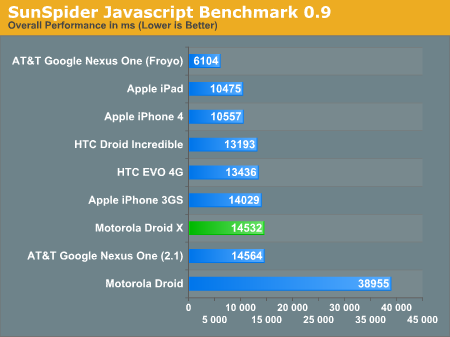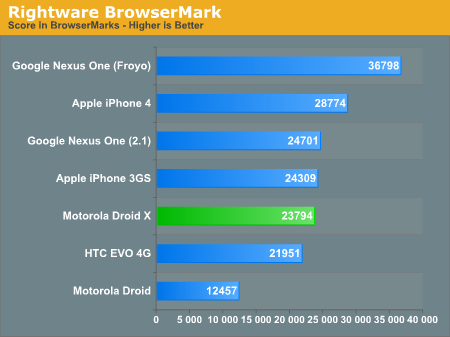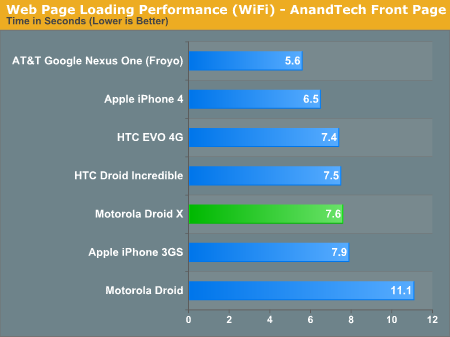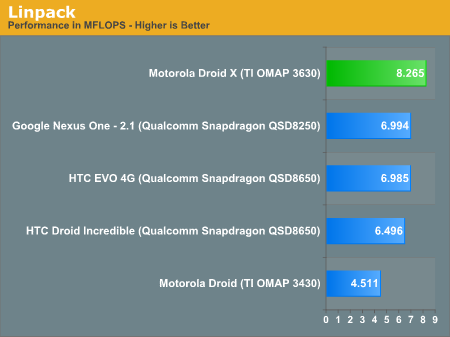Motorola Droid X: Thoroughly Reviewed
by Brian Klug on July 20, 2010 4:27 PM EST- Posted in
- Smartphones
- Motorola Droid X
- OMAP
- Mobile
CPU and General Use Performance
Snapdragon is what Qualcomm calls its SoC, but the CPU itself is called Scorpion. Scorpion is very similar to ARM’s Cortex A8, but with potentially twice the Neon (SIMD FP) throughput. In day to day use however, I don’t expect to see a huge difference between the Scorpion and A8 CPU cores used by Qualcomm and TI respectively.
We’ll start with the targeted browser tests, first SunSpider. A javascript performance test, this benchmark is completely network independent but it measures the performance of the browser as well as the underlying hardware.

SunSpider shows the Droid X roughly on par with the Nexus One running Android 2.1, and a bit slower than the HTC offerings. This benchmark is as much of a software test as it is a hardware one since the move to Froyo (Android 2.2) cuts benchmark times in more than half.
The performance delta from the original Droid to the Droid X is extremely pronounced here. The Droid is just plain slow, and to think it wasn’t that long ago that we were begging manufacturers to use the Cortex A8. The X is a major step forward compared to last year’s high end smartphones.
Next up is the Rightware BrowserMark. This test combines JavaScript and HTML rendering performance:

BrowserMark puts the Droid X in the same league as other Android 2.1 phones. In terms of real world web browsing it doesn’t look like there’s any real difference between the OMAP 3630 and Qualcomm’s Snapdragon.
Turning an eye towards the real world we have a WiFi web page loading test. Here we’ve got a local copy of the AnandTech front page and we’re loading it over WiFi. Note that these results can’t be compared to previous tests as they are running in a slightly different environment than in previous reviews.

The lower level synthetic CPU tests mostly echo our findings thus far - there's very little difference in CPU performance between the OMAP 3630 and Qualcomm's Snapdragon.
The Linpack and Pi tests are very much compiler benchmarks as well as platform tests. We’ve actually had to remove the Froyo Nexus One results from the Linpack graph simply because they make the graph unreadable - Froyo is nearly 3x the speed of the fastest Android 2.1 phone here.


On a relatively level playing field, with all phones running Android 2.1, the Droid X is around twice the speed of the original Droid. The OMAP 3630 even holds a performance advantage over Snapdragon in this test. While Linpack as a workload isn’t very representative of what most people will do with their phones, it is a great FP and cache benchmark.
From a CPU and platform perspective, TI’s OMAP 3630 appears to be just as fast as Qualcomm’s Snapdragon SoC. The two perform very similarly across the board regardless of benchmark. The OMAP most visible advantage is in its GPU. The PowerVR SGX 530, especially running at 200MHz in the OMAP 3630, is at least 50% faster than the present day competition in other Android phones. It should be similar to performance offered by Apple’s A4.










89 Comments
View All Comments
homebredcorgi - Tuesday, July 20, 2010 - link
Who do we have to blame for the “Droid” moniker? Verizon or Motorola?I have a Nexus One and continually get asked, “Is that a Droid?” or “Does that run Droid?” to which I usually reply yes and let sleeping dogs lie…but seriously, why name it so similar to the operating system? And then why make “Droid” a series of phones if your first phone is just known simply as “Droid”?! At least call it the "Droid One" or something to differentiate from the series of phones....
So now we have the Droid, Droid Eris, Droid X, and will soon have the Droid 2 which are all phones in the Droid series, all running on various builds of Android. Yeesh. Could they have made that any more confusing?
All in all, the Droid X looks very nice. I personally think the original Droid had all the flair of a TI-82 calculator (ugly as sin in a blocky retro way), but the Droid X seems to have modernized its looks. Still not sure if I would want a phone that large though….
metafor - Tuesday, July 20, 2010 - link
Verizon owns the rights to the "Droid" trademark from Star Wars. So they decided to capitalize on that and name their whole line of Android phones "Droids".I think it's kinda cheezy but hey, it's selling and is something that people can focus on. With the army of phones coming out every week, it's difficult for the average person to keep up. It helps if they can just go to a store and ask for a Droid.
strikeback03 - Tuesday, July 27, 2010 - link
Actually they have only been using Droid on the high-end phones, the Devour and Ally were not Droids.There is also rumor of a special edition Droid 2 coming with R2-D2 on the battery cover...
lewchenko74 - Tuesday, July 20, 2010 - link
The best, most comprehensive review of the Droid X Ive read so far. Thank you.Just got to wait until it arrives in the UK unlocked now, but personally I think Im going to get the Droid 2 instead with the keyboard.
I am amazed at the pace the smartphone market is moving at. Im 1yr into a 2yr contract with a HTC Hero. It feels like an antique! These 2yr contracts really are a ball and chain.
It also seems like HTC is starting to lag behind Samsung and Moto now in terms of processor and features. Sense also seems a little 'old' compared to other UI layers (or maybe thats just me).
Disappointed that it only runs Android 2.1 when 2.2 is now out though.... That would be like Apple releasing iPhone4 running OS3.2 whilst saying OS4 is out there too but not quite available yet! (I guess Apple actually did that though with the iPad ;-) )
mvmorr01 - Tuesday, July 20, 2010 - link
What app are you using for those CPU utilization graphs? I did a quick search and couldn't find it in the market.Brian Klug - Tuesday, July 20, 2010 - link
It's an application called "SystemPanel" which I found a while back. If you turn logging on, it'll give you some very cool graphs of battery use over time and CPU utilization over days even. Produces some very cool results when I do battery life testing.-Brian
529th - Tuesday, July 20, 2010 - link
First of all I want to say I love mine! :) Bought it the day it came out.Wow what a great review!!!
I didn't know you could run benchmarks on a phone! Linpack!?? WOW awesome!
I can't wait till Froyo! :)
Thanks again chief!
<3 Anandtech reviews!
WaltFrench - Saturday, July 24, 2010 - link
Linpack is a 90s-era benchmark that performs a specific matrix solution. As much as possible, all floating point adds and muls.I've tried in other forums to find an app, prior to 6/1/2010, that actually uses Gaussian elimination with partial pivoting. The particular method works best to find complex patterns within large data sets; that's great for my statistical investment models and for a lot of other stuff. It's strongly suggestive of performance on weather simulations, quantum chemistry, etc., stuff that no sane person would attempt (today) on a smartphone.
Others claim Linpack scores around 40 on overclocked ARM chips with Froyo (the JITting being fabulously helpful for highly repetitive benchmark code). I got ~35 on my iPhone. These scores are ~ 13X–16X what the Linpack author quoted long ago for his 486 (/487, I presume).
I don't know a lot about graphics but presume 3D work that calls for lots of floating point Add/Mul work would get routed to the GPU, so I think these scores are of extremely limited relevance to any smartphone app I can envision.
vshin - Tuesday, July 20, 2010 - link
Where are the antenna attenuation tests? No weak spots?Brian Klug - Tuesday, July 20, 2010 - link
There's definitely attenuation tests in there, and weak spots. The bottom of the phone as expected causes a 15 dB drop. It's on page 14: http://www.anandtech.com/show/3826/motorola-droid-...-Brian